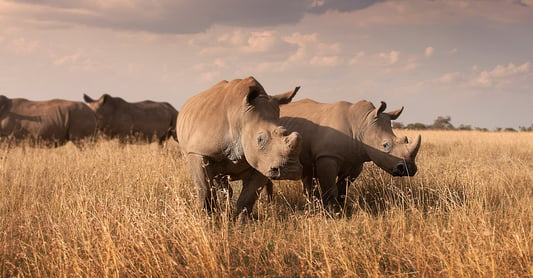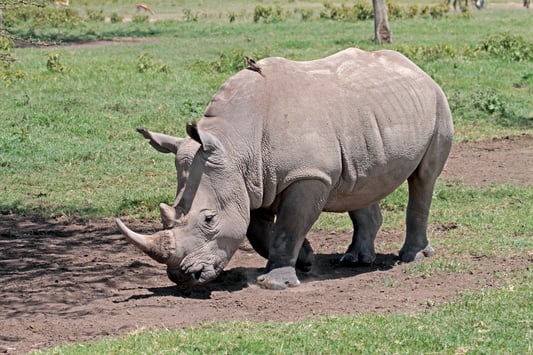March 19th 2018 marked the death of Sudan, the last Northern White rhino male in Africa. He died at the age of 45; euthanized by a veterinarian team due to deteriorating health. He is survived by the last two female Northern White Rhinos, Najin and Fatu.
With only these two elderly female rhinos surviving, the Northern White Rhino are now functionally extinct. Their population has suffered due to poaching, and greed. A rhino horn can sell for US $20,000 per kg and are falsely thought to cure cancer (phys). In the past decade over four hundred species have been declared extinct
 Two of the last three Northern White Rhinos on Earth.
Two of the last three Northern White Rhinos on Earth.
With all of the extinctions of species humans have seen (or created) the world is losing biodiversity rapidly. There are 1,300 species listed on the endangered species act. The International Union for Conservation of Nature (IUCN) red list contains 16,306 species that are at risk for extinction. This is a major issue that is not to be taken lightly. A major loss of biodiversity affects ecosystems as a whole and creates a domino effect. Habitat loss, climate change, direct killing of animals, as well as pollution and invasive species are the main drivers of extinction and biodiversity loss. Finding ways to combat those drivers are the ways to prevent future extinctions.
Preventing extinctions is one method of conservation but some are also working to bring animals back from extinction. In the case of the Northern White Rhino, sperm and eggs have been collected to hopefully be used in surrogates of related species of rhino to restore the population. Using embryos scientists hope to bring back the Northern White Rhino to a point where they can be self-sustaining. Bringing animals back from extinction is just as challenging as it sounds. There is the issue of population genetics. A small restored breeding population would have less genetic diversity than a naturally occurring population. This would reduce resistance to environmental change and disease, both affecting the longevity of revived species in the wild.
 A Northern White Rhinoceros.
A Northern White Rhinoceros.
Another issue that is argued over is the ethical concerns of bringing back the Northern White Rhino while there are still three species of rhino that are critically endangered. The Black, Javan, and Sumatran Rhinos are all critically endangered so should resources be used to try and protect the rhino species that are not extinct? Lastly, would we be able to keep this population of white rhinos safe if we manage to play Lazarus with the species?. Has our world changed in any way for those animals to be able to survive now? If there isn't hope for those animals, why bring them back? Reviving species should not be our first priority when dealing with declining biodiversity. Protecting the species we still have is the first and most important step in trying to preserve biodiversity. Consider what you personally can do to protect endangered or threatened species or contribute to one of the many organizations that make it their mission to do so such as the World Wildlife fund or the International Union for Conservation of Nature.
Andrew Doyle is a Naturalist at Walking Mountains Science Center. He is a Massachusetts tree hugger turned Minturn resident.







